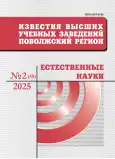Evaluation of phytotoxicity of drilled rocks after roasting
- Authors: Gamm T.A.1, Grivko E.V.1, Gamm А.А.1
-
Affiliations:
- Orenburg State University
- Issue: No 2 (2025)
- Pages: 30-37
- Section: ECOLOGY
- URL: https://journal-vniispk.ru/2307-9150/article/view/348815
- DOI: https://doi.org/10.21685/2307-9150-2025-2-3
- ID: 348815
Cite item
Full Text
Abstract
Background. The oil-bearing rocks of the Orenburg region were selected for the study: dolomite, limestone, clay-siltstone rock, sandstone, the utilization of which is a modern environmental problem. A study was conducted on the toxicity of drilled rocks for living organisms after thermal processing. Materials and methods. The drilled rock, which together with the drilling mud and drilling wastewater, is a waste at the well construction stage, was studied by the method of delayed fluorescence for oil content and biotesting using watercress. Results. It is shown that each geological rock containing oil, depending on its structure and chemical composition, has a certain range of values of the delayed fluorescence coefficients, by which it can be identified in the composition of drill cuttings. With an increase in the oil content in the rock, the value of delayed fluorescence decreases. The standards for delayed fluorescence of drilled rocks containing and not containing oil are established, which can be used to determine the oil content in drilled rocks. Conclusions. When germinating seeds after firing on dolomite and limestone, toxic conditions are created for plants and the drilled rocks cannot be used directly as artificial soil, as well as sludge from a torch. Limestone and dolomite can be used in construction, as an ameliorant or to create artificial soil with specified properties. The most optimal is the use of clay-siltstone rock and sandstone directly for reclamation.
Keywords
About the authors
Tamara A. Gamm
Orenburg State University
Author for correspondence.
Email: hammtam@mail.ru
Doctor of agricultural sciences, associate professor, professor of the sub-department of ecology and nature management
(13 Pobedy avenue, Orenburg, Russia)Elena V. Grivko
Orenburg State University
Email: grivko-ev@mail.ru
Candidate of pedagogical sciences, associate professor, associate professor of the sub-department of ecology and nature management
(13 Pobedy avenue, Orenburg, Russia)Аleksey А. Gamm
Orenburg State University
Email: hammtam@mail.ru
Applicant
(13 Pobedy avenue, Orenburg, Russia)References
- Aralbaeva G.G., Aralbaev Z.T. Trends in the development of the oil and gas industry in Orenburg region. Vestnik Orenburgskogo gosudarstvennogo universiteta = Bulletin of Orenburg State University. 2014;(4):159–164. (In Russ.)
- Ermakova Zh.A., Borisyuk, N.K. Directions for resource conservation in the oil industry of Orenburg region. Vestnik Orenburgskogo gosudarstvennogo universiteta = Bulletin of Orenburg State University. 2014;(8):15–19. (In Russ.)
- Pichugin S.V., Kotel'nikova E.M., Usova V.M., Usov A.A. Results of remote sensing analysis to search for a new type of oil and gas deposits in Orenburg region. Vestnik Rossiyskogo universiteta druzhby narodov. Ser.: Inzhenernye issledovaniya = Bulletin of RUDN. Series: Engineerings research. 2023;24(2):196–205. (In Russ.). doi: 10.22363/2312-8143-2023-24-2-196-205
- Shabanova S.V., Golofaeva A.S., Serdyukova E.A., Mozalova N.P. The impact of oil and gas enterprises on the environment of Orenburg region. Molodoy uchenyy = Young scientist. 2016;(9):61–62. (In Russ.). Available at: https://moluch.ru/archive/113/29061
- Timofeev S.S., Timofeeva S.S., Medvedeva S.A. Biotechnological utilization of oil sludge and drilling waste. Vestnik Irkutskogo gosudarstvennogo tekhnicheskogo universiteta = Bulletin of Irkutsk State Technical University. 2010;(1):158–163. (In Russ.)
- Yagafarova G.G., Safarov A.Kh., Mustaeva A.I. et al. Disposal of carbon-containing drilling waste. Problemy sbora, podgotovki i transporta nefti i nefteproduktov = Problems of collection, preparation and transportation of oil and petroleum products. 2021;(2):105–111. (In Russ.)
- Kanygina O.N., Chetverikova O.G., Lazareva D.A., Sal'nikova E.V. High-temperature phase transformations in iron-containing clays of Orenburg region. Vestnik Orenburgskogo gosudarstvennogo universiteta = Bulletin of Orenburg State University. 2010;(6):113–118. (In Russ.)
- Pat. 2416590, MPKG01N 21/64. A method for producing complex fertilizer from rocks with increased calcium content and without petroleum products. Efremov I.V., Kuz'min O.N., Kolobova E.A., Gamm A.A., Gamm T.A., Mosalova E.I.; applicant and patent holder of the Federal State Budgetary Educational Institution of Higher Education Orenburg State University. Appl. 11.06.2009; publ. 04.20.2011. (In Russ.)
- Kapel'kina L.P., Bardina T.V., Bakina L.G. et al. Metodika opredeleniya klassa opasnosti burovykh shlamov = Methodology for determining the hazard class of drill cuttings. Saint Petersburg: Izd-vo Politekhn. un-ta, 2011:19. (In Russ.)
- Pat. 2262094, MPKG01N 21/64. C1 Russian Federation. Device for recording delayed fluorescence. Ivanova P.A., Mezhueva L.V. Appl. 01.30.2004; publ. 10.10.2005.
- Chesnokova S.M., Chugay N.V. Biologicheskie metody otsenki kachestva ob"ektov okruzhayushchey sredy: ucheb. posobie. Metody biotestirovaniya. Ch. 2 = Biological methods for assessing the quality of environmental objects: textbook. Biotesting methods. Part 2. Vladimir: Izd-vo Vladimir. gos. un-ta, 2008:92. (In Russ.)
- Kartashev A.G. Bioindikatsiya antropogennykh zagryazneniy: monografiya = Bioindication of anthropogenic pollution: monograph. Tomsk: Izd-vo Tomsk. gos. un-ta sistem upravleniya i radioelektroniki, 2019:226. (In Russ.)
- Kartashev A.G. Bioindikatsionnye metody kontrolya okruzhayushchey sredy: ucheb. posobie dlya vuzov = Bioindication methods of environmental monitoring: textbook for universities. Moscow: Yurayt, 2021:138. (In Russ.)
- Terekhova V.A., Kulachkova S.A., Morachevskaya E., Kiryushina A.P. A soil biodiagnostics methodology and features of some bioindication and biotesting methods (review). Lomonosov Soil Science Journal. 2023;78(2):35–45. doi: 10.55959/MSU0137- 0944-17-2023-78-2-35-45
- Ivanykina T.V. The relevance of plant bioindication in conditions of technogenic pollution. Vestnik Amurskogo gosudarstvennogo universiteta. Ser.: Estestvennye i ekonomicheskie nauki = Bulletin of Amur State University. Series: natural and economic sciences. 2010;(51):81–83. (In Russ.)
- Ol'kova A.S. The procedure for selecting biotesting methods under conditions of different types of pollution. Transformatsiya ekosistem = Transformation of ecosystems. 2022;(5):63–75. (In Russ.). doi: 10.23859/estr-220324
- Petyukevich A.E. Modern approaches to bioindication, modeling and analysis of salt (NaCl) stress in plants. Molodoy uchenyy = Young scientist. 2011;(9):82–84. (In Russ.). Available at: https://moluch.ru/archive/32/3686/ (accessed 06.05.2025).
- Sibirtsev V.S., Krasnikova L.V., Schleikin A.G., Mussa Al-khatib. New biotesting method with the application of modern impedance technologies. Scientific and technical journal of information technologies mechanics and optics. 2015;15(2):275–284. doi: 10.17586/2226-1494-2015-15-2-275-284
Supplementary files























